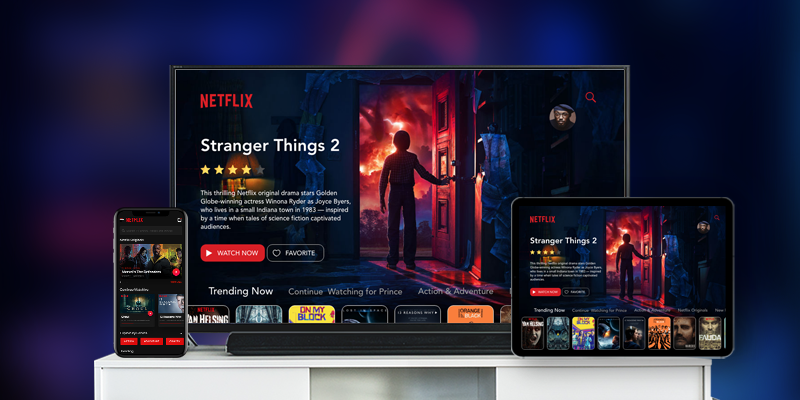The video-on-demand industry has been experiencing a sudden boom for the last few years, especially when Netflix, YouTube, Hulu, Amazon Prime, etc. have become so integrated into our lives. The fame of video on demand is driving tremendous growth and the landscape just keeps getting hotter. With over 167 million paying global subscribers, Netflix leads the overall VOD market. Amazon comes in second with 105 million subscribers in the U.S alone. Mobile devices are the primary channel users to choose for media consumption. The rise of VOD services is also serving as a driving force for people to move to digital media and cut cords. Video-on-demand services are dramatically changing how people consume entertainment. It gives users enormous choices to binge-watch movies and shows at the comfort of their homes.
What drives the growth of video on demand services?
When it comes to the factors that drive the growth of video-on-demand platforms, convenience dominates the list. Video-on-demand services allow consumers to watch content anytime, anywhere, regardless of the devices used. VOD platforms also facilitate multi-user viewing on various devices at the same time, which other media consumption channels won’t be able to provide. For example, Netflix allows multiple users to access the platform on different devices to view programs concurrently. The increasing accessibility of stable Internet connection and smartphones also ensures that users stay connected to their favorite programs every time.
Video on demand trends that will shape the future of the streaming industry
The adoption of the 5G network has already begun and it is expected that 5G will transform the traditional way users consume content. Online consumers will be able to enjoy 4k videos on a 5G network that is 100 times faster than 4G. While rich and original content will still remain significant, you can also expect to see drastic changes in the content distribution system. Here are some of the trends that will shape the future of video streaming.
Increasing demands for originals
With the rise of video-on-demand services, the global audience demand for originals is also increasing. With over 62.6% global demand for its original shows, Netflix is the industry leader. Netflix changed the TV game when it rolled out “House of cards”, such as the current buzz around exclusive and original video content. The current trend is that users choose a video-on-demand service on the basis of exclusive content it offers besides popular TV shows and movies. Hence, if you are thinking about how to create a website like Netflix, consider implementing this content strategy to gain a competitive edge in the market.
Mobile is the preferred channel
In today’s digital age, mobile is the most preferred channel for video delivery and consumption. This growth is fueled by broadband and LTE services. Both streaming services and mobile networks are coming into business partnerships which is further driving the VOD growth. With this in mind, many businesses are adopting a mobile-first strategy. When it comes to the VOD space, the big players like Netflix, Hulu, and Amazon Prime are driving higher traffic share from mobile devices.
Extended business applications
Many businesses are incorporating video streaming into their brand marketing. By leveraging technology, brands have figured out the application of video streaming for extended business use cases. In 2020, more and more companies would be using video streaming for troubleshooting issues and customer service. Using video streaming applications for tutorials, product demos, webinars, etc. will also extend customer support of businesses.
The adoption of hybrid monetization models
A prerequisite for OTT players to sustain in the industry is to generate revenue from their VOD offerings. When it comes to the business models of VOD services, there are 3 main models, Subscription video on demand models like Netflix, Advertisement video-on-demand model like YouTube, and transactional VOD model like iTunes. While these are the 3 main business models, another popular type is the hybrid monetization model. The hybrid revenue model is a combination of SVOD, AVOD, and TVOD models. YouTube, for example, is the perfect hybrid model where it basically works as an advertisement model but also offers pay per view content and premium content to customers.
Fragmentation of content
Another major notable VOD trend is the fragmentation of OTT content. This is quite evident with Disney’s decision to pull its contract with Netflix and Hulu. As Disney launched its own video streaming service, the trend of content fragmentation is well on its way. This trend is expected to continue at a faster pace with intensifying competition in the VOD space.
Live streaming is gaining momentum
Better exposure and higher engagement are compelling businesses of various industries to recognize the potential of live streaming. The reason why live streaming has made such a big impact is that it brings up informative and rich content to viewers in real-time. Users are more frequently viewing content on their smartphones, which has forced brands to change their business approaches, too.
IOT video streaming
Video applications for the Internet of things (IoT) are expanding into a number of industries including endoscopic surgeries and law enforcement as well. IoT streaming is gaining popularity mainly because of the increasing number of devices connected to the Internet.
VOD model is changing the value of content creation and distribution
Video streaming is touching every corner of digital media, transforming not only how content is created, but also how it is distributed. Although more consumers are adopting Internet-based distribution, the majority of U.S households are still consuming TV programs through traditional networks in addition to OTT service. In fact, users are spending more on at-home binge-watching, a trend that is expected to grow. According to the current viewing habits of viewers, immense growth opportunities exist in linear OTT service. Eventually, it is expected that more users would migrate most of their TV consumption to Internet-based content distribution.
Immersive video experiences will become the norm
Screen-based interactions are changing to connected branded experiences with video streaming. Augmented reality is a powerful tool for businesses to narrate rich stories about their products to consumers. All thanks to machine learning and AR technologies that contribute to the delivery of immersive video experiences.
Leverage these trends to improve your business
While video streaming started out as an entertainment medium, it will become one of the most used modern technologies of the 21st century. VOD services are growing at a faster pace, becoming an industry that’s worth billions of dollars. The trends we discussed above are real and continue to revolutionize the industry. Launching a video streaming app for TV and mobile devices is one of the fundamental ways to grow your business audience.
If you are a new business looking to make an entry in the business, begin by creating your streaming platform using a netflix clone. Alternatively, if you are an already existing video streaming business, leveraging these trends by taking examples of businesses that gained positive changes from using streaming technology to grow their brand will prove to be helpful. Use video streaming to boost your social media presence, marketing efforts, and customer experience.
Conclusion
Fast forward to the next 10 years, you will see more video on-demand services mushrooming in the VOD market. In short, there will be more competitors to services like Netflix, Amazon Prime, YouTube, and Hulu. With more businesses seriously thinking about how to create a website like Netflix, the competition will get fiercer in the future. The challenge is not just for existing VOD players, but for traditional satellite TV networks as well to survive in this changing VOD landscape. Stay tuned for the upcoming transformations that would make it easier to satiate the entertainment requirements of online media consumers. Did you enjoy reading this blog? If yes, please share your feedback in the comment section below.
You must be logged in to post a comment.













If you are an entrepreneur who wants to start a video streaming venture, it is the right time for you to enter this field with the lucrative Netflix Clone App.
An app like Netflix is pretty complex. Difficulties arise not only in technical implementation but also in product promotion. Therefore, before starting the development, it is necessary to take into account many factors and create a good business plan.
Thanks for sharing this
Hi Joe Maillet, Really great breakdown of all the entrepreneurs who looking to start a video on demand platform.
But probably readers need to know who provides the best VOD platform like Netflix, amazon prime, Hulu.
I like to list some streaming solutions providers here VPlayed, Vimeo, Contus Vplay, Uscreen.
Creating a Website like Netflix will be a huge task and need to take care of video quality which should be better than other video platforms. Only then we would able to compete with other streaming platforms and also need to update the latest technology.